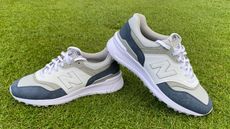TaylorMade Twist Face Explained
TaylorMade's Brian Bazzel explains how Twist Face on the new the M3 and M4 drivers works


TaylorMade Twist Face Explained - Vice President of Product Creation Brian Bazzel explains the new technology in the M3 and M4 drivers, including revolutionary Twist Face
TaylorMade Twist Face Explained
Twist Face is arguably the headline innovation on both the new TaylorMade M3 and M4 drivers.
What is Twist Face?
It represents a change in traditional driver design, specifically the bulge and roll properties of the clubface. Bulge and roll refers to the curvature of the face in both the heel-to-toe and top-to-bottom direction, helping to reduce the effect of off-centre shots through the gear effect.

Mishits tend to occur in a pattern that stretches from low heel on the face to high toe. TaylorMade claims to have discovered through human testing that its previous face design didn’t go far enough to help mishits from these areas return to the centre of the fairway.
Related: TaylorMade M3 Driver Review
As a result, in the high toe area TaylorMade has added loft and opened the clubface to counteract the discovery that on these type of shots, the clubface tends to be more closed to the path than previously thought.
Get the Golf Monthly Newsletter
Subscribe to the Golf Monthly newsletter to stay up to date with all the latest tour news, equipment news, reviews, head-to-heads and buyer’s guides from our team of experienced experts.
On heel strikes, the clubface tends to be more open to the path, so TaylorMade has reduced the loft and closed the face slightly to stop shots missing to the right.
These changes should also make the levels of spin from the sweetspot compared to the heel and toe strikes more consistent, thus reducing the loss of distance experienced on mishits.
Related: TaylorMade M4 Driver Review
We’ve tested both the M3 and M4 drivers and while they were both very forgiving clubheads, it is impossible to measure the effectiveness of Twist Face because there are so many factors that influence the ball’s speed and direction.
Not only would you have to hit the same point on the face every time of the M3 or M4 and another driver that didn’t have Twist Face, but you would then have to deliver the club in exactly the same way – with the same speed, attack angle, face angle, dynamic loft etc, to accurately compare them.
This is not to say Twist Face doesn’t work. We’d recommend you try them out on the course to see if you find more fairways. When you factor in the extra adjustability of the M3 model, we’re confident you will be able to dial in a very specific shape while adding some ball speed and distance to your drives.

Joel has worked in the golf industry for over 12 years covering both instruction and more recently equipment. He now oversees all product content here at Golf Monthly, managing a team of talented and passionate writers and presenters in delivering the most thorough and accurate reviews, buying advice, comparisons and deals to help the reader find exactly what they are looking for. So whether it's the latest driver, irons, putter or laser rangefinder, Joel has his finger on the pulse keeping up to date with the latest releases in golf. He is also responsible for all content on irons and golf tech, including distance measuring devices and launch monitors.
One of his career highlights came when covering the 2012 Masters he got to play the sacred Augusta National course on the Monday after the tournament concluded, shooting a respectable 86 with just one par and four birdies. To date, his best ever round of golf is a 5-under 67 back in 2011. He currently plays his golf at Burghley Park Golf Club in Stamford, Lincs, with a handicap index of 3.2.
Joel's current What's In The Bag?
Driver: Titleist TSR3, 9°
Fairway wood: Titleist TSR3, 15°
Hybrid: Titleist TSi2, 18°
Irons: Ping i230 4-UW
Wedges: Titleist Vokey SM8, 54°. Titleist Vokey SM9 60° lob wedge, K Grind
Putter: Evnroll ER2V
Ball: 2023 Titleist Pro V1x
-
 New Balance 997 SL Golf Shoe Review
New Balance 997 SL Golf Shoe ReviewNew Balance produce some extremely stylish footwear and, in this review, Matt Cradock takes their spikeless 997 SL onto the course
By Matt Cradock Published
-
 I’ve Been A Single-Figure Golfer For 30 Years. These Are The Seven Keys To Getting (And Keeping) A Low Handicap
I’ve Been A Single-Figure Golfer For 30 Years. These Are The Seven Keys To Getting (And Keeping) A Low HandicapIt takes time and it takes a bit of work, but there are key techniques and strategies you can employ to reach your golfing goals
By Fergus Bisset Published